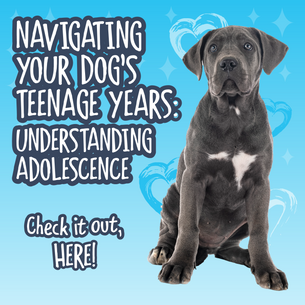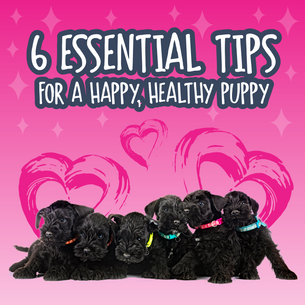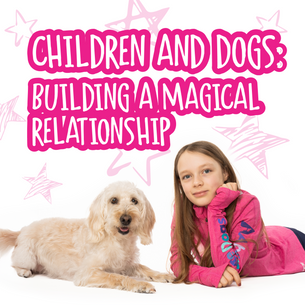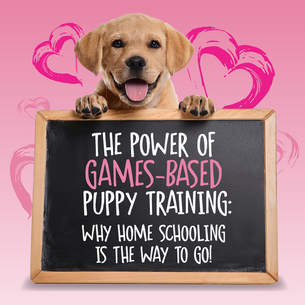Owning a dog is one of life's most rewarding experiences. The bond between humans and dogs can be incredibly special. And yet, here at AbsoluteDogs we know that it's not always smooth sailing. Dog ownership comes with its fair share of challenges and struggles.
Not every dog naturally has the skills needed to fit into the world they are part of and make the very best choices in every situation - and if you find yourself facing an unexpected behaviour challenge or training blip it can quickly take the shine off that dog-owning dream you started out with.
The good news is that every common dog-owning woe has solutions!
And the key to that transformation is being able to teach your dog the skills they need and equip them to make the very best choices in every situation.
Imagine your dog's brain as a unique puzzle made up of different concepts. These concepts include calmness, focus, disengagement, optimism, and self-control. They shape your dog's personality and influence their choices and behaviour in various situations. Every behaviour struggle can be traced back to a lack of certain concepts.
The exciting part is that your dog's brain is adaptable and can be reshaped. At AbsoluteDogs we believe the very best way to achieve that is by playing games that target and strengthen those individual concepts!
Just as importantly, your dog’s brain has to be shaped FOR the situations they might encounter in life before being put IN those situations.
Let’s explore five of the most common dog-owning behaviour problems and provide practical tips - and games - which will laser-target those struggles and turn them into amazing strengths!
Dog Owning Struggle 1: Leash Pulling and Walking Woes
Does your dog’s pulling drive you crazy? Are you tired of days where your dog is the one taking you for a walk instead of it being the other way round?
Pulling on lead can turn a leisurely walk into a tug-of-war battle. It’s frustrating!
Why does your dog pull?
Dogs don’t naturally understand how to walk on lead. In fact, they come with a built in opposition reflex, which means they naturally pull against the lead!
Your dog might also have learned from experience that pulling on the lead is the most efficient way to get to that really good sniff, or reach the park that little bit faster. Dogs' brains are really efficient, so they will repeat things that get rewarded.
You might not intentionally be rewarding your dog’s pulling - but if those experiences hold more value to your dog than hanging out close to you, you can bet your dog is going to keep choosing to pull! Instead of being the source of the very best fun, you’re the one limiting that fun and holding your dog back - literally and metaphorically.
So how do you stop your dog pulling on the lead and achieve that lovely loose-lead walking dream you’ve been waiting for?
Top Tip 1: Ditch the Bowl and spend your dog's daily pot of value (their food) growing value for hanging around you and deliver awesome rewards in proximity!
Top Tip 2: Play proximity games and have strategies in place to make sure your dog's brain is WITH YOU when you step out the door for a walk! The AbsoluteDogs Pull No More Playbook is full of top tips and strategies - and it’s free to download!
Top Tip 3: Grow your dog's disengagement skills so that they learn that the environment and all the exciting, distracting things it has on offer are actually none of their business!
Want to learn more? Jump into the AbsoluteDogs 10 Days to Stop Pulling course and transform your walks!
Dog Owning Struggle 2: Excessive Barking
Dogs bark to communicate. It’s a completely natural behaviour. But excessive barking can drive you barking mad!
Barking is one of the most common struggles faced by dog owners, yet it can be one of the most damaging. Having a dog who barks excessively - whether that’s at things they can see out of the window, at visitors, at the doorbell, or seemingly at every little noise (even ones you can’t hear!) can be a huge relationship withdrawal. It can divide households, destroy family relationships and cause rifts with neighbours.
Why does your dog bark?
The first thing to understand about barking is that it is the outward display of an emotion your dog is feeling. That might be fear, it might be excitement, or it might be frustration. Your dog might bark because they want to play, because they’re worried when left alone, or because they’re in pain.
Just like any habit that you develop over time, such as biting your fingernails, the more you practise doing it the more it becomes your default when you’re excited, scared, bored or anxious. It’s exactly the same for dogs. The more your dog barks, the more they will do it. Dogs become more of what they do every day. What they practise, they become!
So how do you stop your dog barking and help them embrace their inner calm canine?
Top Tip 1: Identify and minimise triggers. Is your dog bored, anxious, or alerting you to something? Once you pinpoint the cause, you can work on solutions. Does your dog need more mental and physical stimulation? Do you need to block access to visual triggers, or mask external sounds with music? Consider using crates, puppy pens and closed doors to limit access to areas of the house where barking happens most often.
Top Tip 2: Rehearse the good stuff! Consider putting your dog on lead to prevent rehearsal of unwanted barking, reward calm choices, provide plenty of enrichment such as long lasting chews to promote calmness, and be sure your dog has time every day to rest, relax and empty their stress bucket.
Top Tip 3: Grow your dog’s skills. By targeting those key concepts and investing value in calmness, you will help your dog learn to choose a more appropriate response to their barking triggers. The AbsoluteDogs Bark No More Playbook is full of top tips and strategies - and it’s free to download!
Want to learn more? Jump into the AbsoluteDogs 10 Days to Stop Barking course and transform your noisy household to one of peace and quiet!
Dog Owning Struggle 3: Jumping Up
Does your dog have springs in their paws? If your dog's favourite go-to behaviour is jumping up and you’re wondering whether they are actually part-Tigger, it can be exhausting! Having a dog who bounces head height to say hello when you come home, jumps all over your visitors and launches themselves at people you meet on walks can be incredibly stressful.
If your dog regularly decorates the trousers of strangers they come across on walks with paw prints, their bouncing is accompanied by inappropriate mouthing and nipping, or there are young children involved, this behaviour can be especially challenging or even dangerous.
Why does your dog jump up?
Dogs are wired to greet face-to-face as part of a friendly meeting sequence. Dogs who jump up have learned that this is a great way to get attention – possibly from a very early age. This often happens when a dog is a tiny puppy and only becomes an issue when that puppy has tripled in size and is now planting its sizable paws on your chest or knocking small children over with its enthusiasm to say hello! Dogs repeat behaviours that earn rewards, and few things are more rewarding than your attention.
So how do you stop your dog jumping and help them learn the value of keeping their paws grounded?
Top Tip 1: Think about what you do want and put your focus there! If you’d like your dog to sit, touch their nose to your open palm or bring you a favourite toy as a calm way of greeting you when you come home rather than jumping up, put value into those behaviours through fun games played outside of situations where your dog struggles to contain their bounce!
Top Tip 2: Use management strategies to limit rehearsal. While you’re helping your dog see value in calm greetings and in keeping those paws firmly on the floor, limiting their opportunities to rehearse anything other than those awesome choices will really supercharge your progress. Having your dog on lead, or behind a baby gate can prevent greeting until they are calm. The AbsoluteDogs Jump No More Playbook is full of top tips and strategies - and it’s free to download!
Top Tip 3: Play games that teach your dog the skills of self-control and disengagement. Reward for calmness, and put lots of value into keeping those paws on the floor by scattering some of your dog’s daily food allowance on the ground any time they might be tempted to jump.
Want to learn more? Jump into the AbsoluteDogs 10 Days to Stop Jumping course and help your dog learn the value of staying grounded!
Dog Owning Struggle 4: Running Away When Called
Does your dog run away from you rather than coming when you call their name?
Do you dream of being able to unclip the lead without having to scan the environment in every direction just to make sure there aren’t any tempting distractions that are going to entice them away? Wouldn’t it be amazing if, with all the freedom in the world, your dog valued being near above every other available option?
Here at Absolute Dogs we believe that coming when called is a matter of safety. Knowing your dog will listen and respond to your recall is also the key to unlocking true off leash freedom, without the worry that your dog may go too far or get themselves into trouble.
Why does your dog run away?
Dogs often learn through experience that coming close means the end of the fun. If you always call your dog to put them on lead, take them home from their fun adventures or bring them inside from the garden, you will very easily take the shine off their recall. It’s just not a good deal!
Depending on your dog’s skills - those concepts that shape their brain and make up their personality - they may also be missing some of the key skills needed to understand that there is more value in hanging out close than in chasing off into the distance. A dog who lacks the skill of disengagement and has no value for proximity might chase wildlife or chickens, and struggle to come away from the fun times they’re having with other dogs - because those things hold more value than anything you can offer. Quite simply, you're not giving your dog as good a deal as the environment! This is especially true if the environment is too much of a challenge for your dog’s current skills.
So how do you fix your dog’s broken recall and help them learn the value of sticking close?
Top Tip 1: Make coming when called a really great deal! Identify the things your dog truly values and make those part of your reward experience! If your dog loves to chase after wildlife on walks, flip that on its head and reward their recall with an opportunity to chase you! Find experiences that light them up, play games and become more exciting to your dog than anything the environment can tempt them with. If you’re new to AbsoluteDogs games based training, our 25 Day Sexier Than a Squirrel Challenge is a brilliant place to start.
Top Tip 2: Be unpredictable. Call your dog and then let them go again. Make sure your recall isn’t a predictor of a bad deal, or the end of the fun. Variety is the spice of life! Check out our Recall Super-Hacks for some super strategies to build into your walks.
Top Tip 3: Play games that boost your dog’s value for proximity and make coming back when called the very best deal - every time!
Want to learn more? Jump into the AbsoluteDogs Recall Rescue course and unlock true off-leash freedom with your dog.
Dog Owning Struggle 5: Zoomies, Humping and the Witching Hour
Have you experienced it? That time of the day - often in the evening - when your dog suddenly begins racing round in a frenzy, grabbing clothes, jumping, humping, pestering and action prompting? It’s most commonly seen in puppies, whose sudden hyperactive bursts of energy are typically accompanied by nipping and biting that can seem alarmingly aggressive and catch you off guard - but dogs of any age can get the zoomies.
Why does it happen, and, more importantly, how can you tackle it?
Your dog’s brain is efficient. In fact, it’s so efficient that their energy levels increase in anticipation of predictable events that happen throughout the day. If one day, or one specific part of a day, is full of high arousal activities and non-stop excitement, your dog’s brain will gear up the next day already set to anticipate excitement. It’s not a conscious decision on your dog’s part to get their disco pants on and start having a party. It happens without them even thinking about it.
If you take your dog for a walk at the same time every day, then leading up to that point you’ll notice their energy levels start to increase.
Owners who are faced with the challenge of a witching hour often have a fairly predictable routine, dictated by the demands of work and schedules which can’t be flexed. Your dog may spend a good portion of the day pretty relaxed. Then, at the same kind of time each day, everyone comes home, or stops work. There’s more noise and more activity, particularly if you have children who come home from school. This is typically the part of the day where you might have more time to interact with your dog - take them for a walk, or do some fun training.
When the witching hour strikes, all that’s happening is that your dog’s efficient brain is gearing up, ready for that anticipated interaction.
Your dog’s stress bucket is also an important part of the picture.
Just the same way as we do, dogs have stress thresholds. We like to represent this as a bucket. Many things pay into your dog’s bucket – excitement, scary things, novelty, pain, and itchiness are just some of the common bucket-fillers.
Some dogs have very big buckets that fill slowly and empty easily. Others have much smaller buckets which fill much more quickly, and overflow much more easily.
As your dog’s bucket fills with the events of the day, they get closer to their threshold. Whenever the bucket overflows you will see this in an outward display of behaviour. Your dog might bark more, startle at noises that they would normally be able to ignore, or be less able to relax.
If your dog struggles with a full bucket, they are going to have less capacity to deal with things that excite or worry them, and be less able to embrace calmness - so helping your dog keep their stress bucket as empty as possible is vitally important.
So how can you stop the witching hour and restore calmness to your evenings?
Top Tip 1: Ditch the Routine around those predictable events that create all that anticipation and energy. Dogs who have less predictable schedules are much happier in everyday life, more flexible and more chilled out.
Top Tip 2: Alongside being predictably unpredictable, you can make a huge impact on this struggle by identifying those points of day where your dog is anticipating high energy interactions, or exciting events, and swapping those events out for calm activities. You’ll more than likely find your dog’s efficient brain and their disco-ready body struggle with calmness to begin with, so you’ll need to meet them halfway. Over time, you’ll see those witching hour zoomies lessen as the anticipation of high arousal events reduces.
Top Tip 3: Staying level headed when your dog is running a wall of death around your living room, using your curtains as a tug toy, stealing precious items or humping your leg is challenging - and yet adding your own frustrated energy to the situation is guaranteed to make it worse. Instead, make a conscious effort to stay calm, keep your own energy low, and you will conquer those witching hour struggles!
Owning a dog isn't always easy, but whatever challenges you encounter can be overcome with patience, training, and understanding.
By addressing struggles head-on, playing games that target those concepts your dog needs and making effective use of management to limit opportunities for your dog to rehearse less desirable behaviour choices, you can build a stronger bond and build a truly beautiful relationship that will last a lifetime.
Remember that every dog is unique, and every journey will look different - but games are the very best way to conquer any struggle.




